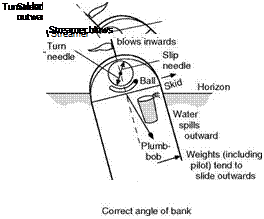Correct and incorrect angles of bank
We have so far assumed that the aeroplane is banked at the correct angle for the given turn. Fortunately the pilot has several means of telling whether the bank is correct or not (Fig. 8.6, overleaf), and since the methods help us to understand the mechanics of the turn, it may be as well to mention them here.
A good indicator is the wind itself, or a vane, like a weather cock, mounted in some exposed position. In normal flight and in a correct bank the wind will come from straight ahead (neglecting any local effects from the slipstream); if the bank is too much, the aeroplane will sideslip inwards and the aeroplane, and pilot if he is in an open cockpit, will feel the wind coming from the inside of the turn, whereas if the bank is too small, the wind will come from the outside of the turn, due to an outward skid on the part of the aeroplane.
Another indication would be a plumb-bob hung in the cockpit out of contact with the wind. In normal flight this would, of course, hang vertically; during a correct bank it would not hang vertically, but in exactly the same position relative to the aeroplane as it would in normal flight, i. e. it would bank with the aeroplane. If over-banked the plumb-line would be inclined inwards; if under-banked, outwards from the above position. This plumb-bob idea, in the form of a pendulum, forms the basis of the sideslip indicator which is provided by the top pointer of the so-called turn and bank indicator. The pointer is geared so as to move in such a way that the pilot must move the control
 |
Angle of bank too small
Fig 8.6 Effects of correct and incorrect angles of bank
column away from the direction of the pointer, this being the instinctive reaction. Sometimes a curved transparent tube containing a metal ball is used, and again the control column must be moved away from the indication given on the instrument. It is interesting to note that in early aeroplanes the slip indi
cator was, in effect, a spirit level, the tube being curved the opposite way and with a bubble (in liquid) instead of the ball; the pilot was then told to ‘follow the bubble’ – not the instinctive reaction. Nowadays such simple mechanical devices are being replaced by electronic or digital displays which neverthless often mimic the apearance of the older instruments. Figure 8.6 shows how a tumbler full of water would not spill even when tilted at 80° in a correct bank; if the bank were too small it would spill outwards over the top lip of the tumbler!
Lastly, during a correct bank the pilot will sit on his seat without any feeling of sliding either inwards or outwards; in fact, he will be sitting tighter on his seat than ever, his effective weight being magnified in the same proportions as the lift so that if he weighs 800 N in normal flight he will feel that he weighs 8000 N when banking at 84°! If he over-banks he will tend to slide inwards, but outwards if the bank is insufficient.











